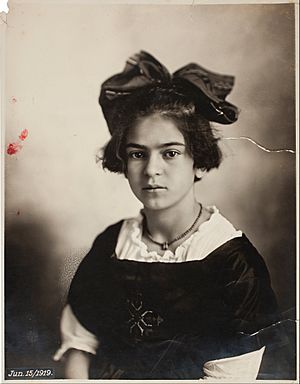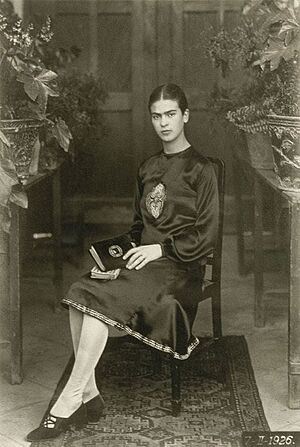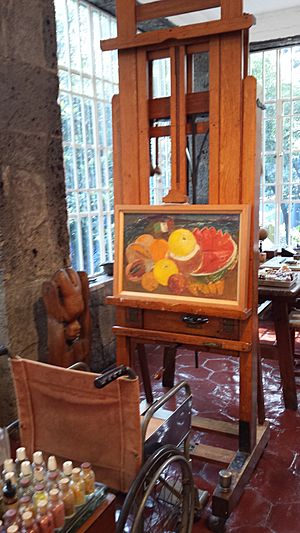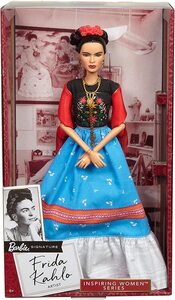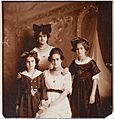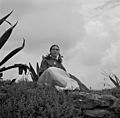Frida Kahlo facts for kids
Quick facts for kids
Frida Kahlo
|
|
|---|---|
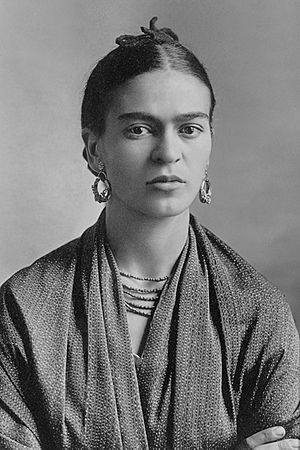
Kahlo in 1932
|
|
| Born |
Magdalena Carmen Frida Kahlo y Calderón
6 July 1907 Coyoacán, Mexico City, Mexico
|
| Died | 13 July 1954 (aged 47) Coyoacán, Mexico City, Mexico
|
| Other names | Magdalena Carmen Frieda Kahlo y Calderón, Frieda Kahlo |
| Education | Self-taught |
| Known for | Painting |
|
Works
|
|
| Movement |
|
| Spouse(s) |
(m. 1940) |
| Parents |
|
| Relatives | Cristina Kahlo (sister) |
| Signature | |
Magdalena Carmen Frida Kahlo y Calderón (July 6, 1907 – July 13, 1954) was a famous Mexican painter. She is known for her many portraits and self-portraits. Her art often showed her own life and feelings. She mixed real-life events with dream-like fantasy in her paintings. Frida Kahlo also painted about her experiences with chronic pain and health challenges.
Contents
Frida Kahlo's Early Life
Frida Kahlo was born in Coyoacán, Mexico City. Her father was German, and her mother was mestiza (of mixed heritage). Frida spent most of her life in her family home, called La Casa Azul (The Blue House). Today, this house is a museum dedicated to her.
Childhood Challenges
When Frida was a child, she became sick with polio. This illness affected her leg and caused her to start school later than other kids. She went to kindergarten and primary school in Coyoacán. For fifth and sixth grades, she was taught at home.
Frida's father wanted her to attend a German school. However, she was soon expelled for not following the rules.
Discovering Art
Frida enjoyed art from a young age. She learned drawing from her father's friend, Fernando Fernández. She filled many notebooks with her sketches.
When she was 18, Frida was in a serious bus accident. This accident caused her pain for the rest of her life. She had to stay in bed for three months after the accident. During this time, she started to paint.
Her mother gave her a special easel so she could paint in bed. Her father lent her his oil paints. A mirror was placed above her easel so she could paint herself. Painting became a way for Frida to think about who she was. She once said, "I paint myself because I am often alone and I am the subject I know best."
Most of her early paintings were portraits of herself, her sisters, and her school friends.
Frida Kahlo's Artwork and Style
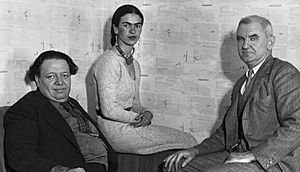
In 1925, Frida started working to help her family. She became an apprentice for a printmaker named Fernando Fernández. He was impressed by her talent. At this time, she did not think art would be her career.
In the late 1920s and early 1930s, Frida traveled in Mexico and the United States. She traveled with her husband, the Mexican artist Diego Rivera. During these travels, she developed her unique art style. She found inspiration in Mexican folk culture. She mostly painted small self-portraits. These paintings often combined ideas from ancient Mexican cultures and Catholic beliefs.
Becoming Famous
A surrealist artist named André Breton became interested in her paintings. He helped Frida have her first solo art show in New York in 1938. This show was very successful. Another show followed in Paris in 1939.
Even though the French show was not as popular, the Louvre Museum bought one of her paintings, The Frame. This made Frida the first Mexican artist to have a painting in their collection.
Throughout the 1940s, Frida showed her art in Mexico and the United States. She also worked as an art teacher. She taught at the Escuela Nacional de Pintura, Escultura y Grabado and helped start the Seminario de Cultura Mexicana.
Frida's health became worse in the 1940s. She had her first solo exhibition in Mexico in 1953. She passed away shortly after, in 1954, at age 47.
Frida Kahlo's Later Years
As Frida gained fame in Mexico, her health continued to decline. A surgery to help her spine did not work. Her paintings from this time show her poor physical state. Some of these include Broken Column (1944) and The Wounded Deer (1946).
During her last years, Frida mostly stayed at La Casa Azul. She painted many still lifes. These paintings showed fruits and flowers, often with political symbols like flags.
Her Last Exhibition
Photographer Lola Alvarez Bravo knew Frida did not have much time left. So, she organized Frida's first solo exhibition in Mexico in April 1953. Frida's doctors told her to stay in bed. But she had her four-poster bed moved from her home to the gallery! She arrived in an ambulance and was carried on a stretcher to her bed. She stayed there for the whole party.
This exhibition was a big cultural event in Mexico. It also received attention from newspapers around the world. In the same year, the Tate Gallery in London showed five of her paintings in an exhibition about Mexican art.
In 1954, Frida was in the hospital again in April and May. She started painting again after a year. Her last paintings included political works like Marxism Will Give Health to the Sick (c. 1954) and Frida and Stalin (c. 1954). She also painted the still-life Viva La Vida (1954).
Frida Kahlo's Health and Passing
In 1950, Frida spent most of the year in the hospital. She had several surgeries on her spine. After leaving the hospital, she mostly stayed at La Casa Azul. She used a wheelchair and crutches to move around.
During her final years, Frida focused on political causes as much as her health allowed. She rejoined the Mexican Communist Party in 1948. She worked for peace, for example, by collecting signatures for the Stockholm Appeal.
In August 1953, part of Frida's right leg was removed due to an infection. This made her very sad and worried. She also needed more painkillers.
In her last days, Frida was mostly in bed with a lung illness. However, she made one last public appearance on July 2, 1954. She joined Diego Rivera in a protest against the CIA invasion of Guatemala. She seemed to know her death was near. She drew skeletons and angels in her diary. Her last drawing was a black angel, which some believe was the Angel of Death. She wrote, "I joyfully await the exit – and I hope never to return – Frida."
The protest made her illness worse. On the night of July 12, 1954, Frida had a high fever and was in extreme pain. On July 13, 1954, her nurse found her dead in her bed. Frida was 47 years old. Doctors said she died from a blood clot in her lungs.
Her body was taken to the Palacio de Bellas Artes, a beautiful art palace. It was displayed under a Communist flag. The next day, she was cremated as she wished. Her ashes are kept in a special urn at La Casa Azul, which became a museum in 1958.
Frida Kahlo's Recognition and Legacy
Frida Kahlo's art was not widely known until the late 1970s. Then, art historians and activists rediscovered her work. By the early 1990s, she became a very important figure in art history. She also became an icon for different groups, including Chicanos, the feminism movement, and the LGBTQ+ community.
Her work is celebrated around the world. It is seen as a symbol of Mexican national and indigenous traditions.
Frida Kahlo's Personal Life
Frida Kahlo's interest in politics and art led her to join the Mexican Communist Party in 1927. There, she met fellow Mexican artist Diego Rivera. They got married in 1929. He was 42, and she was 22.
The couple divorced in 1939 but remarried on December 8, 1940. Frida and Diego did not have children together.
Frida Kahlo Quotes
- "They thought I was a Surrealist, but I wasn’t. I never painted dreams. I painted my own reality."
- "I paint flowers so they will not die."
- "At the end of the day, we can endure much more than we think we can."
- "Nothing is worth more than laughter."
- "The most important part of the body is the brain. Of my face, I like the eyebrows and eyes."
Interesting Facts About Frida Kahlo
- Frida was born in Mexico, but her father was German.
- Her name was originally spelled "Frieda". "Friede" means "peace" in German.
- Frida survived both polio and a bus crash.
- She married a man with a very long name: Diego María de la Concepción Juan Nepomuceno Estanislao de la Rivera y Barrientos Acosta y Rodríguez.
- She sometimes made her facial hair look stronger in her self-portraits.
- Because of the bright clothes she wore, children sometimes asked her, "Where’s the circus?"
- She was born and died in the same house, called "La Casa Azul" (The Blue House). It is now the Frida Kahlo Museum.
Commemorations and Tributes
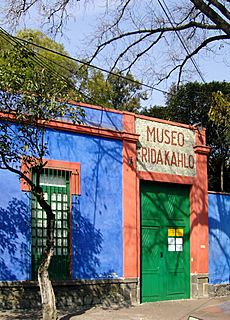
Frida Kahlo's life and art have been remembered in many ways:
- Her home, La Casa Azul, opened as a museum in 1958. It is one of the most popular museums in Mexico City.
- In 1985, a park in Coyoacán was named Parque Frida Kahlo. It has a bronze statue of her.
- In the United States, she was the first Hispanic woman to be honored with a U.S. postage stamp in 2001.
- She was added to the Legacy Walk in Chicago in 2012. This is an outdoor display that celebrates LGBT history.
- Many artists have used Frida Kahlo's images in their own works.
- Her life and art have inspired plays and performances.
- In 2018, Mattel released a Barbie doll of Frida Kahlo.
- In 2018, a street in San Francisco was renamed Frida Kahlo Way.
- In 2022, Swatch released a watch based on her painting The Frame.
Images for kids
-
Self-Portrait with Thorn Necklace and Hummingbird (1940), Harry Ransom Center
-
Kahlo with husband Diego Rivera in 1932
-
Frida photographed in 1932 by her father, Guillermo
-
1937 photograph by Toni Frissell, from a fashion shoot for Vogue
-
Effigy of Kahlo for Day of the Dead at the Museo Frida Kahlo
See also
 In Spanish: Frida Kahlo para niños
In Spanish: Frida Kahlo para niños


